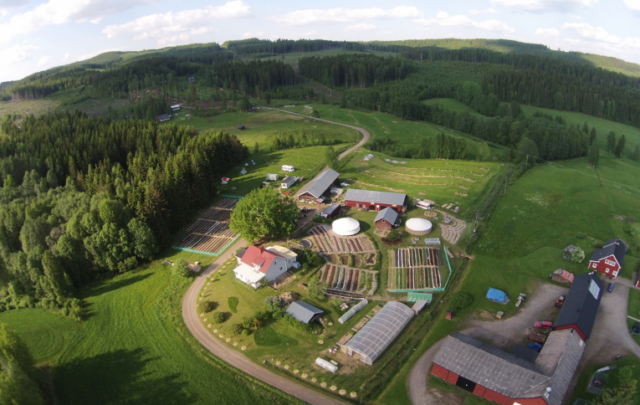If you have followed energy issues from anywhere other than a cave on a mountain peak, you’ve probably heard technoutopians utter some variation on the following sentence two or three hundred times “We walked on the moon – of course we can do whatever it takes to shift from fossil fuels to some other source of energy.” The moon shot is perceived as the ultimate example of “put in a quarter and get out the technological outcome you want” in our history. If we could set out to put a man on the moon and do it in less than decade, can’t we do anything we want to, with just enough ingenuity?
Because I am married to The Astrophysicist (more often known as Eric when I am playing him for comic relief ;-)) who among other things teaches the history of space exploration, the moon shot comes up more than perhaps in most marriages. Over the years we’ve both been struck by the disparity between how people view the moon shot (as proof that anything technically feasible can be promptly enacted) and how the actual history of our space program and the moon shot actually teach very different lessons – lessons equally relevant to our energy future, but not nearly as palatable. In this essay I am joined by the Astrophysicist as a collaborator.
Let’s take the perceived lessons of the moon shot and subsequent space program as they are perceived, and then as they actually are, distinguishing myth from reality.
Myth : We walked on the moon – that means all we have to do is see a need for a new technology and turn good old American ingenuity towards it, and it will be accomplished. Thus, no need to worry about the transition away from fossil fuels.
Reality: It is tempting to retroactively write a story in which a united society saw the need to win the race to the moon and worked in unity to achieve it. In fact, however, it is a story about political manipulation and technical limits as much as achievement. The space race was a comparatively unimportant part of the conflict between the US and Soviet Union in a military or economic sense – but one with enormous political importance – a huge and expensive publicity stunt.
The perception that we were losing the space race and that the space race was of great geopolitical importance to Kennedy, reeling from various other disasters. Kennedy saw a political opportunity to emphasize the importance of the space race and manipulate events so that America could “win” a particular victory.
In fact, the history of the moon shot is mostly about the implicit acknowledgement of technological limits. We know for a fact that Kennedy and his scientific advisors considered a number of space related projects, including the building of a space-station (more on that later) to give Americans the necessary victory that would distract from a whole host of more important political issues. The reason the moon shot was chosen was not because we wanted so desperately to make “one giant step for mankind” – we imputed that significance later – but because it was virtually the only space-related project that we were fairly certain we could “win” at, because the Soviets weren’t yet focused on it. Various other space projects were considered and abandoned as technically possible but not likely to win – Kennedy evaluated that the Soviets recovery from World War II would delay a moon landing long enough for an American “victory.”. After considerable analysis, the moon shot was selected as both politically appealing and within our extant technical capacities. We had the technology.
Going to the moon was impressive, but it wasn’t a case of taking an extant need, determining to fill it, and doing so rapidly and in response that need. Instead, it was about creating a need and moving a sideshow (the space race) to the center of things (this is, of course, normative in politics and always has been). It was an important sideshow for any number of historical reasons but not in any way parallel to facing a national crisis and engendering a technological response that prevents disaster. Indeed, it involved us acknowledging, with the case of the space station, that time was inadequate to complete many desired projects.
Myth: We can do what we want, unencumbered by limits, and go on doing it, expanding to fill available needs.
Reality: These two myths go hand in hand with the re-writing of our space narrative as the turn towards a kind of national unity. The previous lesson points out that the moon shot isn’t a good parallel to the need for a response to an energy crisis, because we didn’t need to go to the moon. On the other hand, the time horizon does seem to be inspiring. Kennedy announced that we would get to the surface of the moon within a decade, and to nearly everyone’s surprise, 8 years later, we did. That is an impressive technological achievement. It belies the fact that the moon shot didn’t take us into a new space age where those technologies were widely implemented and impacted most people’s daily lives – something that would be necessary in a even broadly parallel “energy race.”
As the Astrophysicist puts it to his class, saying “isn’t it great to live in the space age” is rather like saying in 1986 “Isn’t it great you live in the internet age?” More than 50 years into the “space age” fewer than 500 human beings have even entered low earth orbit (which my husband correctly describes to his undergraduates in Albany NY as “about as far away as New Jersey”) and only 24 have ever gone further. Manned space flight has remained an occasional sideshow, but has never generalized or spread, despite the claims that regular commercial space flight will happen any day now (for those of you with a few hundred thousand bucks to spare). The difference between the internet is that it actually came to have a regular impact on ordinary people – space never did.
Moreover, what isn’t widely known but is important is that this decline in manned space flight was something that began immediately after the moon shot itself – Apollo 18, 19 and 20, all expansions of the moon program, were cancelled within months of the moon landing. Indeed, due to lack of general interest and problems in the Soviet Space program, there was some consideration of cancelling the moon landing itself. The public’s passion for the space race had waned and new political priorities had taken their place – there was debate over whether the expense was justified, but since most of the 20 billion dollars had already been spent, it was seen as a go-ahead.
What we can see is that manned space flight and the race to the moon are not only bad parallels in many ways to the kind of radical societal transformation that would enable us to replace oil and other fossil fuels with renewable energy in an equitable and widespread way, but also that the moon landing and the subsequent manned space program were not, in fact cases of the successful and scalable achievement of a technological goal that could be further built upon, but instead, an example of hitting a demonstration high note that was barely reproduceable and never had a meaningful impact on most lives. That’s not what’s needed, obviously, in regards to energy.
Myth: The arrow of technological progress always points straight towards the bullseye.
Reality: Eric has a children’s book from 1960 that sat on his shelf during his boyhood in the 1970s called _You Will Go to the Moon_. Besides the humorous pictures of a little boy who travels to the moon as one routinely did in this imagined future. What’s interesting about it is that the boy makes his moon launch from a 2001-style rotating space station in orbit. This was the original vision of a moon launch, and the original imagined purpose of space stations – rather than taking incredible quantities of energy and resources to launch to the moon directly from the ground, which was clearly not feasible if scaled, moon launches would necessarily occur from orbit where you wouldn’t need to fight gravity or atmosphere.
When JFK announced that we would shoot for the moon by the end of the decade he functionally put an end to this kind of moon launch model. By focusing on the quick and dirty from-the-ground launch using disposable rockets, he shifted attention away from building a space station that would make this act reproducable and enable further (ideally) deep space missions. In a way, the nail in the coffin to going into space regularly was the first shot to the moon.
Because all resources were focused on these kinds of expendable rocket surface launches, and indeed because a generation of space-related expectations were built upon witnessing these kinds of surface launches, no extra-atmospheric space station that could have launched further exploration was ever built. By the time of the moon shot, the political will and economic resources to build such a space station were gone.
Remember those cancelled Apollo missions? Well, Skylab, the only space station the US has ever launched independently, was built with repurposed pieces from those cancelled space missions. The goals and purpose of a space station in 1973 were also repurposed from old Apollo missions – ie, to stay competitive with the Russians whose space station (also not a platform to further exploration) was launched in 1971, and who were dominating the study of long term human presence in space,
To the extent that Skylab had any goals that furthered expansion of the space program, it was to see how people survived in space over the longer term. Before the launch of Skylab the longest any American had been in space was about 2 weeks, but during the year Skylab was in use, the longest stay there was 84 days, well below the Russian record at that point. So even as a possible research step towards more manned space flight or long term life support, space stations were faltering, and the US space station program failed to take us in that direction – or rather, took us in the direction we were actually already heading – towards the abandonment of manned space flight for the most part.
It is here, i think that the parallels between the Moon Shot and our current need to make an energy transition are clearest and most important. We picked, for the purpose of political distraction, a goal that actually took us away from being an effective presence in space – by focusing on something that looked impressive but didn’t get us anywhere important and that we knew couldn’t easily be generalized, we failed to hit the “bullseye” of an actual “space age” in which manned space flight was meaningfully integrated into our future.
Looking ahead 40 years from the last moon landing (which happened four months after Sharon was born) none of the nations with space programs that either involve manned space flight or ambitions to entry into that club are all floundering to decide what the actual point of manned space flight is. The moon shot in many ways was not the beginning of anything except the end of real progress in manned space flight. It marked, in many ways, the start of a decline. We can’t afford to have that be true of a transition to renewable and other energy sources. In this sense, the message of the moon launch is very different than most people think.
At the end of his class on the history of space exploration, when discussion turns towards the future, Eric shows his class an image of abandoned Apollo-era launch platforms from the 1970s (not the one above, the other is from an old documentary and not available to us, but the image at the top will give you a general sense) that look like nothing so much as a modern Stonehenge, concrete trilithons with a patina of age and a clear air of decrepitude. It is this, perhaps that people should (but often won’t) take away from the moon shot – not that it proves we can do anything we want, whenever we want, but that we must choose carefully our goals and recognize our limits more clearly than we have in our past.
Sharon Astyk and Eric Wood






